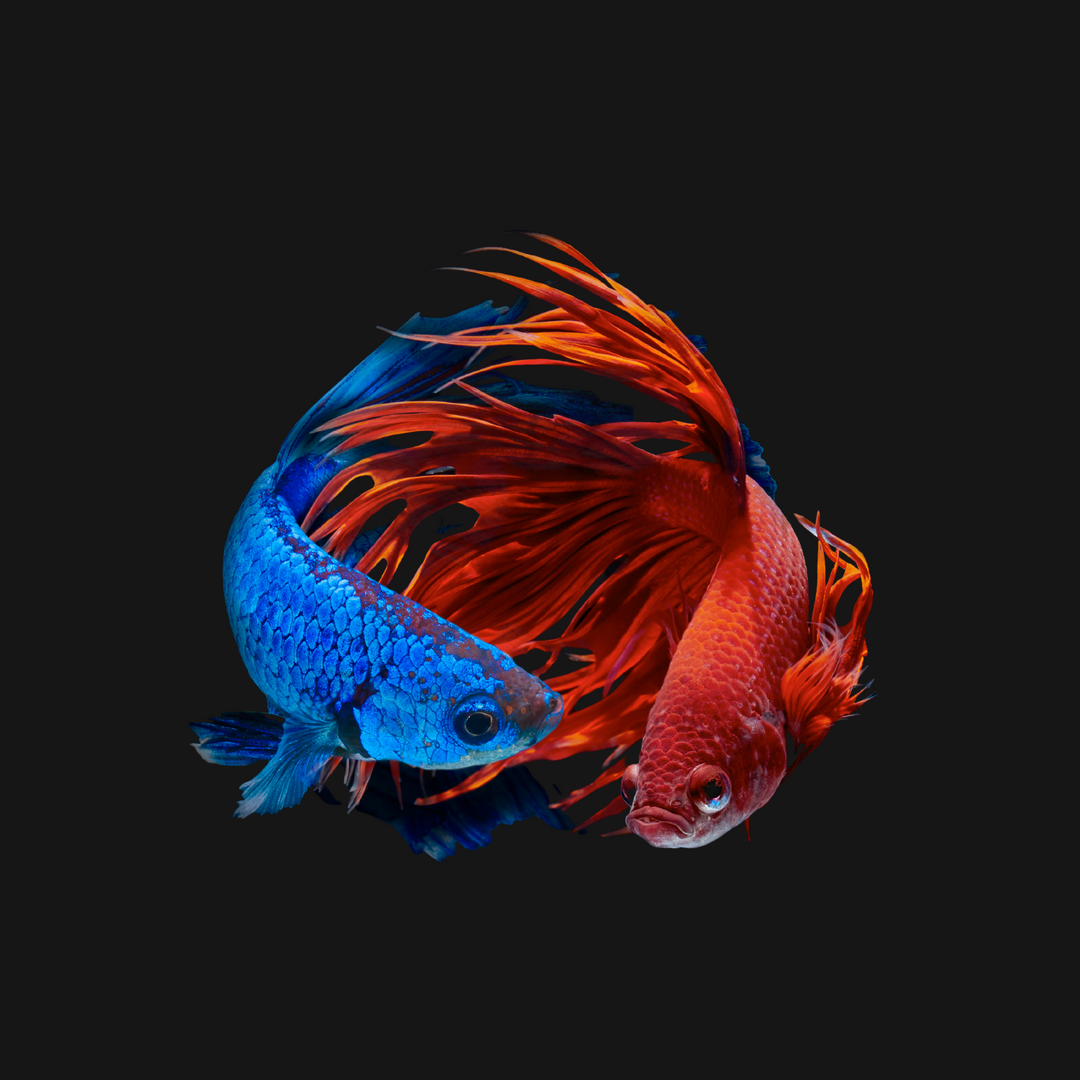Dumbo Halfmoon Betta Care Guide for Optimal Health
Table of Content
AppearanceTank maintenance and requirements
Which diet is best for Super Delta Dumbo Betta Fish?
Suitable Tank Mates for Half-Moon Dumbo Betta Fish
Dumbo Halfmoon Betta Care Guide
FAQs
The halfmoon dumbo ear betta is a lovely addition to your home aquarium, whether you're a novice or an expert aquarist, bringing beauty and peace to your aquatic world. It is a beautiful gem among water sports enthusiasts. This fish, frequently referred to as just "betta," is a member of the Osphronemidae family and is native to Southeast Asia's freshwater ecosystems. It is also called the Siamese fighting fish due to its aggressive behaviour. Let's read more about halfmoon dumbo betta.
| Category | Rating |
| Care Level | Moderate |
| Colour | Green, Blue, Purple, Orange, Green, Red |
| Lifespan | Up to 3 years |
| Diet | Carnivores |
| Size | Up to 2.5 inches |
| Temperature | 72°-81° Fahrenheit |

Appearance
Dumbo halfmoon betta has a distinctive semi-circle-shaped tail, and a labyrinth organ. It provides the ability to breathe on the upper water surface. But other fish species can breathe through their gills. Their large pectoral fin can reach approximately 180 degrees, a stunning display of colours and patterns is produced because to its amazing pectoral fin spread. These fascinating pectoral fins make them more unique in fish species.
Dumbo halfmoon betta male typically has brighter colours and recognizable fins like other bettas. Male Dumbo Halfmoon bettas can also display a variety of colours.
The layers of pigment in bettas' skin and a layer of transparent cells on their surface give them their distinctive colours. The pigment or colour layers, from the deepest to the surface, are red, yellow, black, iridescent blue/green, and a layer with a metallic look. Compared to the male dumbo halfmoon, female bettas lack flowing fins. But these also have vibrant colours.
If you observe that your dumbo half-moon betta's colour starts to change, do not be too shocked. But this can be a cause for worry. When these fish are stressed or unwell, their vibrant, vivid colours occasionally fade.
A white dumbo half-moon betta might occasionally be discovered, although these are uncommon. However, the albino halfmoon dumbo betta is even more distinctive. There is almost no colour on this fish. The colourless, nearly translucent scales of the albino halfmoon elephant ear betta are striking. The eyes are pink or crimson, and the skin is shimmering pink. Learn more about Dumbo in this our recent blog Interlink the blog.
Tank maintenance and requirements
To properly care for your super delta dumbo betta, you must pay great attention to the water quality in the aquarium. Maintaining a constant water temperature between 72° and 81°F, with 75°F being the best average, ensures their comfort and well-being. To do this, consider purchasing a water heater, which is simple to find at aquarium supply stores. Your half-moon dumbo ear betta should not be exposed to too cold water because this might make them tired and more susceptible to illness.
As we know, dumbo halfmoon betta is an active swimmer and needs enough space. They cannot survive in a little fishbowl. Keeping them in a tank with a minimum of 4 gallons is preferable. But for the larger fish and other tankmates, you just need 20-gallon tanks.
Add the aquatic plants and moderate lighting to make the tank more beautiful, and light helps to set the day and night cycle of the fish. Pick fragile plants to avoid harming your betta's sensitive fins. Dumbo halfmoon also enjoys hiding in quiet places; therefore, it's a good idea to include some smooth rocks in the aquarium. Ensure none of these rocks have protruding edges that could cut your betta.
These fish prefer to live in waters with little current and water movement. Reduce water flow as much as possible to calm the tank's environment. It's essential to maintain suitable water parameters. The general hardness (GH) should be between 5 and 20. Dumbo halfmoon betta cannot tolerate pH levels that are excessively acidic or alkaline, so make sure they are between 6.8 and 7.5.
Which diet is best for super delta dumbo betta fish?
Maintaining a proper diet is crucial for the health and vitality of your half-moon dumbo betta fish. Dumbo half-moon has a carnivore nature. These fish eat small crustaceans, zooplankton, and insect larvae in their natural habitat. To make them happy, prioritize using animal proteins as the primary food source. In addition to several other protein-rich like daphnia, black worms, brine shrimp, mosquito larvae, and small insects are also ideal alternatives. Choose the feed wisely for bettas because they have tiny digestive tracts. As carnivores, half-moon dumbo ear betta should not be fed plant-based foods.
Set a feeding schedule for your betta. Only give them that they can finish in 3 to 5 minutes. The recommended dosage is 1-2 micro betta pellets twice daily. Removing uneaten food as soon as possible after the feeding session is essential to avoid overfeeding and preserve the water's quality.
Inadequate feeding can result in health problems like obesity, constipation, and swim bladder disease, while an abundance of food in the tank might contaminate the water. It's interesting to note that bettas may go up to two weeks without eating. However, this is not recommended or suitable for them.
Suitable Tank Mates for Half-Moon Dumbo Betta Fish
Although male dumbo halfmoon is often solitary and territorial, they can coexist peacefully with different fish species under certain circumstances—including enough room and appropriate hiding places. Halfmoon elephant ear betta tankmates should have tropical, communal, and nonterritorial, and not have long, flowing fins.
Female bettas are less aggressive and territorial. They can put up with more or bigger tankmates. It's crucial to remember that bettas should only be kept permanently together if it's for temporary reproductive purposes. Corydoras catfish, Tetras, Snails, Loaches, Mollies, Snails, and shrimp are the ideal tankmates for the half-moon betta fish.
Dumbo Halfmoon Beta Care Guide
Half-moon dumbo ear betta fish is easy to care for but with the basic care practice. Like other aquarium fish, their well-being depends on keeping the aquarium clean. It is advised to do routine tank cleanings to avoid the buildup of harmful organisms and algae. Monitoring minerals like magnesium, calcium, strontium, and trace elements is simple with the help of an aquarium water testing kit, which is easily accessible at aquarium supply stores.
By following these rules and providing a clean, well-balanced habitat, you can keep your dumbo halfmoon betta healthy and content without needing laborious care routines.
Like any pet fish, halfmoon bettas are prone to several illnesses, many of which are brought on by unfavourable tank conditions. These ailments can be avoided with appropriate care and diligence.
Diseases
Your super delta dumbo betta's health depends on maintaining ideal water quality and other vital factors. Keep an eye on disease symptoms, including:
- The vibrant colours of the betta have noticeably faded.
- Unusual inactivity or sluggishness.
- Fins tightly clamped to the body prevent a fish from moving gracefully.
- Loss of appetite.
The following are some frequent ailments that can affect the half-moon elephant ear bettas:
Fin rot
Fin rot disease, also called tail rot. Minor tears on the fin are the first symptom of this disease. If unattended, it may worsen and eventually result in the loss of the entire fin. The leading causes are poor water quality and high ammonia levels.
For moderate cases, enhance the water's quality and think about keeping the fish in a bigger tank.
Velvet (Gold Dust Disease)
This disease is caused by the Oödinium parasite, which can be very upsetting for Halfmoon ear bettas. It frequently happens when fresh fish or live plants are added to the tank without quarantine. Ulcers and lesions are the symptoms of velvet disease.
To avoid this, you should maintain the proper conditions of the water.
Ick
Among betta fish, ick is a common disease. It is also known as ich or White Spot illness. The same external parasite that causes velvet also causes ick, irritating Halfmoon's skin. It causes the fish to act like they are trying to scratch an itch by rubbing against objects inside the tank, giving rise to the name "ich."
The fish's body frequently develops white patches from persistent scratching. They are wounds and white patches. Without proper treatment, Ich can result in anxiety, sluggishness, appetite loss, and even death.
Conclusion
Taking care of your halfmoon dumbo ear betta fish can be a rewarding and fun experience. You can ensure the health and well-being of your lovely and distinctive fish by giving them the proper tank conditions, a balanced diet, and a close check on any potential health problems. Remember that preserving water quality and tank cleaning regularly is also essential. Your dumbo halfmoon will flourish with the proper care, showcasing its brilliant colours and beautiful fins. Explore our enchanting dumbo collection sales here and find out the best deals for yourself https://thailandbettafish.com/collections/dumbo
FAQs
How frequently should dumbo halfmoon betta fish be fed?
Half-moon betta fish should be fed once or twice a day. You need to provide them protein-rich diet.








Leave a comment